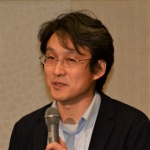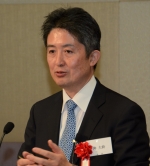September 19, 2018
The 146th
"Whole-Body Clearing and Beyond"
September 19, 2018 at Courtyard by Marriott Tokyo Ginza Hotel
Systems biology, which is Dr. Ueda’s field of specialization, is an academic discipline designed to gain an understanding of biological phenomena as a system, incorporating systems engineering approaches and analytic methods into biology. Development of experimental technology is an important area of activity. In 2014, Dr. Ueda developed a whole-body Clearing method named CUBIC, designed to observe all the cells constituting an organism, and thus enabling observation of each and every cell in the organism's body or its organs. The method has enabled the production of single-cell resolution 3D image data. Data on the brain of a mouse only the size of the nail on the little finger of a human being occupies a huge 14 terabytes. 3D images created from 1.3 million photographic data items showed that the mouse's brain is made up of 72,239,062 cells. This was the first time that the actual number of cells, something that had only been estimated up to then, finally became clear. In 2017, chemical compounds for clearing became available commercially. Great expectations have been placed on the technology's potential for elucidating the mechanism of cancer metastasis and methods for identifying and treating mental illnesses such as depressive psychosis and schizophrenia, about which much remains unknown. Looking back on the development of CUBIC, Dr. Ueda says that it is the result of the efforts of researchers across many disciplines, including medicine, chemistry, information science, etc., and that the physical sciences and life sciences are becoming ever closer.
Dr. Hiroki Ueda
Professor, Department of Systems Pharmacology, Graduate School of Medicine, The University of Tokyo,
Team Leader, Laboratory for Synthetic Biology, RIKEN Center for Biosystems Dynamics Research
Lecture record
March 27, 2018
The 145th
"Expectations for Science and Technology that Support the Sustainable Development"
March 27, 2018 at Courtyard by Marriott Tokyo Ginza Hotel
As the top authority in the area of water resource engineering and Senior Vice Rector at the United Nations University, Professor Oki was involved in the development of the Sustainable Development Goals (SDGs) adopted by the United Nations in 2015. He responded to the query “Is there any contradiction in the term sustainable development?” by looking back on past international activities.
The Millennium Development Goals (MDGs) adopted by the UN in 2001 comprised eight goals and 21 targets to be achieved by 2015. He pointed out that, of the eight goals, only three were achieved, namely, “eradication of extreme poverty and starvation,” “combating HIV/AIDS, malaria and other diseases” and “assurance of environmental sustainability.” He stated that results were produced by nations where economic progress is underway. To achieve the 17 goals of the SDGs adopted by the UN in 2015, he pointed to the fact that not only national governments but also private businesses have adopted mechanisms to integrate these goals into their business management. He said further that “sustainability will stop if economic development stops. Also, business development is essential for social stability, and businesses must commit themselves to SDGs as an investment for the future.”
Dr. Taikan Oki
Professor, Institute of Industrial Science, The University of Tokyo/Senior Vice-Rector, United Nations University
Lecture record








